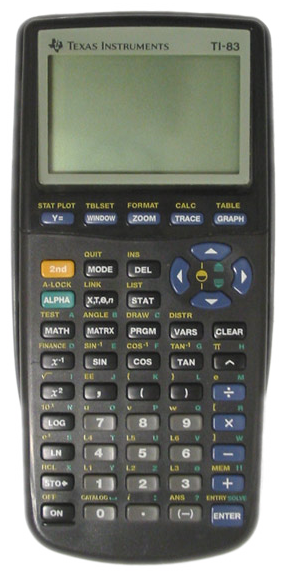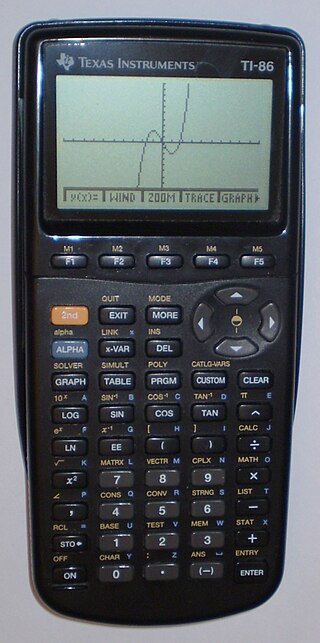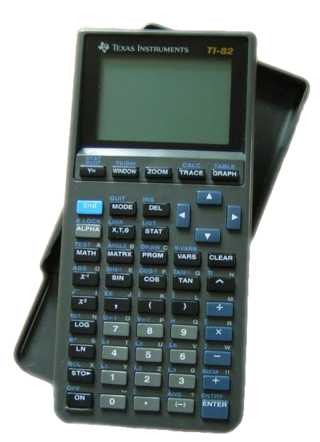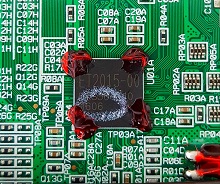
The TI-89 and the TI-89 Titanium are graphing calculators developed by Texas Instruments (TI). They are differentiated from most other TI graphing calculators by their computer algebra system, which allows symbolic manipulation of algebraic expressions—equations can be solved in terms of variables, whereas the TI-83/84 series can only give a numeric result.

A graphing calculator is a handheld computer that is capable of plotting graphs, solving simultaneous equations, and performing other tasks with variables. Most popular graphing calculators are programmable calculators, allowing the user to create customized programs, typically for scientific, engineering or education applications. They have large screens that display several lines of text and calculations.

The TI-83 series is a series of graphing calculators manufactured by Texas Instruments.

The Speak & Spell line is a series of electronic hand-held child computers by Texas Instruments that consisted of a TMC0280 linear predictive coding speech synthesizer, a keyboard, and a receptor slot to receive one of a collection of ROM game library modules. The first Speak & Spell was introduced at the summer Consumer Electronics Show in June 1978, making it one of the earliest handheld electronic devices with a visual display to use interchangeable game cartridges. The company Basic Fun brought back the classic Speak & Spell in 2019 with some minor changes.

The TI-86 is a programmable graphing calculator introduced in 1996 which was produced by Texas Instruments. The TI-86 uses the Zilog Z80 microprocessor. It is partially backwards-compatible with its predecessor, the TI-85.

The TI-85 is a graphing calculator made by Texas Instruments based on the Zilog Z80 microprocessor. Designed in 1992 as TI's second graphing calculator, it was replaced by the TI-86, which has also been discontinued.

The TI-84 Plus is a graphing calculator made by Texas Instruments which was released in early 2004. There is no original TI-84, only the TI-84 Plus, the TI-84 Plus Silver Edition models, and the TI-84 Plus CE. The TI-84 Plus is an enhanced version of the TI-83 Plus. The key-by-key correspondence is relatively the same, but the TI-84 features improved hardware. The archive (ROM) is about 3 times as large, and the CPU is about 2.5 times as fast. A USB port and built-in clock functionality were also added. The USB port on the TI-84 Plus series is USB On-The-Go compliant, similar to the next generation TI-Nspire calculator, which supports connecting to USB based data collection devices and probes, and supports device to device transfers over USB rather than over the serial link port.

The TI-82 is a graphing calculator made by Texas Instruments. The TI-82 was designed in 1993 as a stripped down, more user friendly version of the TI-85, and as a replacement for the TI-81. It was the direct predecessor of the TI-83. It shares with the TI-85 a 6 MHz Zilog Z80 microprocessor. Like the TI-81, the TI-82 features a 96×64 pixel display, and the core feature set of the TI-81 with many new features.

The TI-80 is a graphing calculator designed by Texas Instruments in 1995 to be used at a middle school level.
TI-BASIC is the official name of a BASIC-like language built into Texas Instruments (TI)'s graphing calculators. TI-BASIC is a language family of three different and incompatible versions, released on different products:

The TI 73 series is a series of graphing calculators made by Texas Instruments, all of which have identical hardware.

The Texas Instruments LPC Speech Chips are a series of speech synthesizer digital signal processor integrated circuits created by Texas Instruments beginning in 1978. They continued to be developed and marketed for many years, though the speech department moved around several times within TI until finally dissolving in late 2001. The rights to the speech-specific subset of the MSP line, the last remaining line of TI speech products as of 2001, were sold to Sensory, Inc. in October 2001.

The Zilog eZ80 is an 8-bit microprocessor from Zilog, introduced in 2001. eZ80 is an updated version of the company's first product, the Z80 microprocessor.

The TI-Nspire is a graphing calculator line made by Texas Instruments, with the first version released on 25 September 2007. The calculators feature a non-QWERTY keyboard and a different key-by-key layout than Texas Instruments's previous flagship calculators such as the TI-89 series.
A graphing calculator is a class of hand-held calculator that is capable of plotting graphs and solving complex functions. There are several companies that manufacture models of graphing calculators. Texas Instruments is a major manufacturer.
On graphing calculators, an assembly shell is a program that is used to run other programs written in the calculator's native machine code rather than the calculator's standard high-level programming language. While all assembly shells can run assembly programs, some can also run high-level programs. For example, MirageOS and DoorsCS, two popular TI-83+ assembly shells, can run TI-BASIC programs by placing a colon as the first bit of code on the first line in the program.
In computing, a character set is a system of assigning numbers to characters so that text can be represented as a list of numbers. For example, ASCII assigns 61 to "A". As part of the design process, Texas Instruments (TI) decided to modify the base Latin-1 character set for use with its calculator interface. By adding symbols to the character set, it was possible to reduce design complexity as much more complex parsing would have to have been used otherwise.

The Texas Instruments signing key controversy resulted from Texas Instruments' (TI) response to a project to factorize the 512-bit RSA cryptographic keys needed to write custom firmware to TI devices.
Cemetech is a programming and hardware development group and developer community founded in 2000. Its primary software focus is calculator programming for TI and Casio graphing calculators, and its primary hardware focus is on mobile and wearable computing hardware. Among its most notable projects are the Doors CS shell for the TI-83+ series of graphing calculators, the Clove 2 dataglove, the Ultimate Calculator, and the CALCnet / globalCALCnet system for networking graphing calculators and connecting them to the Internet. The Cemetech website hosts tools for calculator programmers, including the SourceCoder TI-BASIC IDE and the jsTIfied TI-83+/84+ emulator. The founder of the site, Dr. Christopher Mitchell, began the site to showcase his personal projects, but since its early days, it has branched out to become one of the several major sites of the TI calculator hobbyist community and a source for hardware and programming development assistance. It has incubated many software and hardware projects beginning in the calculator community at its roots but including microprocessor development, general electrical engineering, desktop applications, and mobile/web applications.

TI-BASIC 83,TI-BASIC Z80 or simply TI-BASIC, is the built-in programming language for the Texas Instruments programmable calculators in the TI-83 series. Calculators that implement TI-BASIC have a built in editor for writing programs. While the considerably faster Z80 assembly language is supported for the calculators, TI-BASIC's in-calculator editor and more user friendly syntax make it easier to use. TI-BASIC is interpreted.














